Dutch Missionaries and Deaf Education in Africa between 1960-1990
Summary of project provided in Kenyan Sign Language
This video can not be shown because you did not accept cookies.
You can leave our website to view this video.Introduction
Around the mid-twentieth century, a number of Catholic, missionary congregations from the Netherlands were involved in deaf education in East Africa, notably in Kenya.
The missionaries were trained in deaf education in Ireland or the UK, as well as in the Catholic Instituut voor Doven (Institute for Deaf, IvD) located in St. Michielsgestel (see Map 1). The latter placed a strong emphasis on the importance of training speech skills to deaf children.
Various archives in the Netherlands hold documents pertaining to the Dutch missionaries’ work in Deaf education in Kenya and other countries. These documents are mostly in written or spoken Dutch.
With this project, we have taken stock of these sources and translated some of the most relevant ones into English, to make them more accessible to researchers outside of the Netherlands. We focused on deaf schools in Kenya with heavy involvement of Dutch missionaries.
We present archival materials held in two archives on Catholic heritage in the Netherlands: Erfgoedcentrum Nederlands Kloosterleven (EKL) and Katholiek Documentatie Centrum (KDC) (see Map 1). These archives hold documentation on various congregations.
Three congregations seem to have been particularly involved in education for deaf children, all in South West Kenya: Franciscans of Oudenbosch in Nyang’oma, Ursulines of Bergen in Mumias and the Brothers of Tilburg in Homa Bay/Sikri (see Map 2). We compiled an inventory of relevant sources. In the next section we explain how the inventory is set up and how it can be used. There you can also find an overview of the congregations, schools, location and language-education (see Table 1).
Map 1 - Home locations of the Dutch congregations, the Catholic archives, and the IvD in St. Michielsgestel
-
Katholiek Documentatie Centrum (KDC) Katholiek Documentatie Centrum (KDC)
-
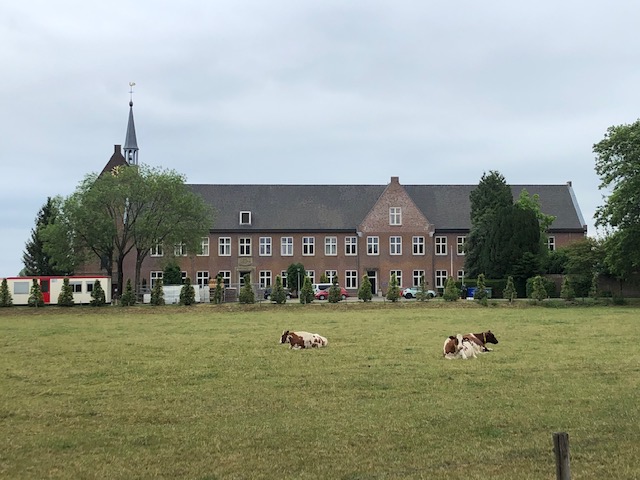 Erfgoedcentrum Nederlands Kloosterleven (EKL) Erfgoedcentrum Nederlands Kloosterleven (EKL)
Erfgoedcentrum Nederlands Kloosterleven (EKL) Erfgoedcentrum Nederlands Kloosterleven (EKL) -
Brothers of Tilburg Brothers of Tilburg
-
Ursulines of Bergen
-
Franciscans of Oudenbosch
-
Institute fot Deaf Education (Instituut voor Doven; IvD)
Archives and inventory
Table 1 - Summary of schools based on information retrieved from archival materials
| Congregation | Location | School | Establishment | Teaching method |
| Franciscans of Oudenbosch | Nyang'oma | Primary school for the deaf | 1961 | Oral English + Total Communication |
| Technical school for the deaf | 1966 | Oral English | ||
| Ursulines of Bergen | Mumias | Primary school for deaf children | 1961 | Oral English |
| Secondary school for deaf girls | 1970 | Oral English | ||
| Workshop for deaf girls | 1980 | Oral English | ||
| Brothers of Tilburg | Homa Bay/Sikri | Technical training institute for the blind and deaf (agriculture) |
1970 | Sign Language |
As can be seen in Table 1, two primary schools were established by two congregations. Besides that, four institutes were created where deaf children could enroll for technical training after finishing primary school.
The listed archival materials consist of (1) documents, (2) diaries, (3) photos, and (4) transcripts of interviews with missionaries or people who were involved in deaf education in Kenya. Four of these interviews were conducted around 1980 as part of an oral history project about missionaries (i.e. Project KomMissieMemoires [KMM]), these interviews can be found at the archive of KDC. Three other interviews were conducted by us as part of this project, including one with the former director of the Tabora School for the Deaf, in Tanzania. All interviews were held in Dutch so transcripts are made in Dutch and translated in English.
Map 2 - Deaf schools and Dutch congregations located in Kenya and Tanzania
-
Kenya - Nyang'oma - Sisters of Oudenbosch
-
Kenya - Mumias - Ursulines of Bergen
-
Kenya - Homa Bay/Sikri - Brothers of Tilburg
-
Tanzania - Tabora - White Fathers
Data on missionaries in Deaf Education in East Africa
The inventory is sorted by congregation and/or mission. Furthermore, the inventory provides information about the archive where the material is held, the archival number, the year of appearance, the topic, the source type and a description about the object.
Deaf Education data in the Heritage Center for Dutch Monastic Life (Erfgoedcentrum Nederlands Kloosterleven)
Contact Details
Address: Kloosterlaan 24, 5435 XD Sint AgathaTelephone: +31485311007
E-mail: info@erfgoedkloosterleven.nl
Website: www.erfgoedkloosterleven.nl
Deaf Education data in the Catholic Documentation Center (Katholiek Documentatie Centrum)
Contact Details
Address: Erasmuslaan 36, 6500 HA Nijmegen
Telephone: +31243612457
E-mail: info@kdc.ru.nl
Website: www.ru.nl/kdc
English transcripts of Dutch interviews held with missionaries about deaf education in East Africa (+/- 1980)
All interviews were held in Dutch by KomMissieMemoires around 1980 as part of an oral history project about missionaries. The relevant parts are translated into English by us and these transcripts can be read here:
- Sister Laetitia (1983; Franciscans of Oudenbosch - Nyang'oma)
- Sister Basildis (1980; Ursulines of Bergen- Mumias)
- Brother Philotheus (1980; Brothers of Tilburg - Homa Bay/Sikri)
- Brother Roeland (1979; Brothers of Tilburg - Homa Bay/Sikri)
(For sources of the interviews, see the inventory of Catholic Documentation Center)
English transcripts of Dutch interviews held in 2020 with one missionary (Tabora) and two employees (Nyang'oma)
As part of this project, three other interviews were conducted by us. All interviews were held in Dutch so transcripts are made in Dutch and translated in English. The English transcripts can be read here:
- Piet Bergman, the former director of the Tabora School for the Deaf. He is a White Father and went on a mission to Tanzania;
- Brechtje, a female speech therapist who worked in the Primary School for the Deaf in Nyang'oma with the Franciscans of Oudenbosch;
- Harm, a technical schooled man who led the Technical School for the Deaf in Nyang'oma. He also worked with the Franciscans of Oudenbosch.
Photos missionaries in deaf education Africa
During our archival search to materials related to deaf education in East Africa (and beyond), we encountered several photographs and we will share these here. Below the gallery, an image description is given and the sources of the photographs are listed.
-
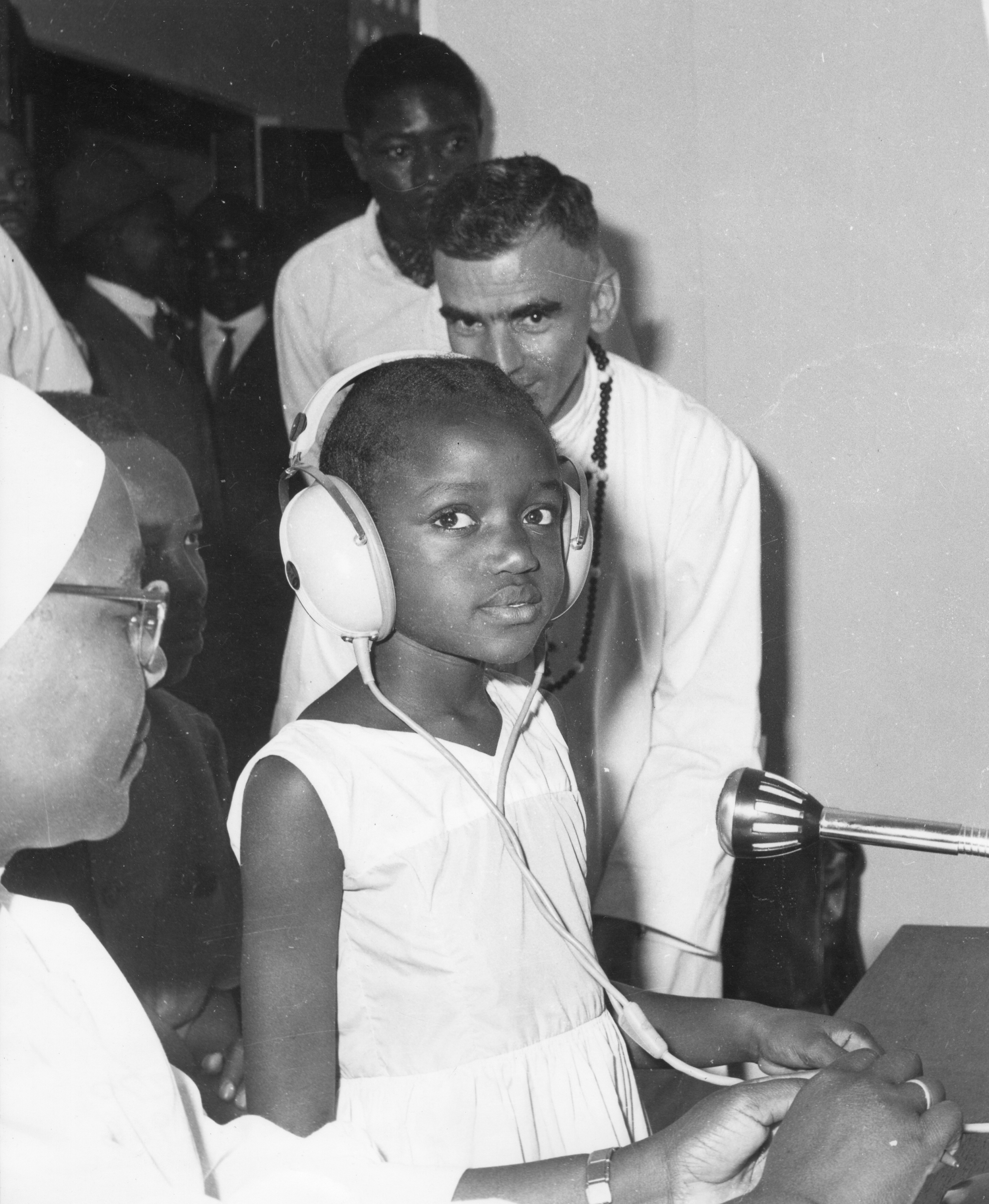
1. Deaf girl with headphone looking in the camera (Tabora, Tanzania, 1965) -
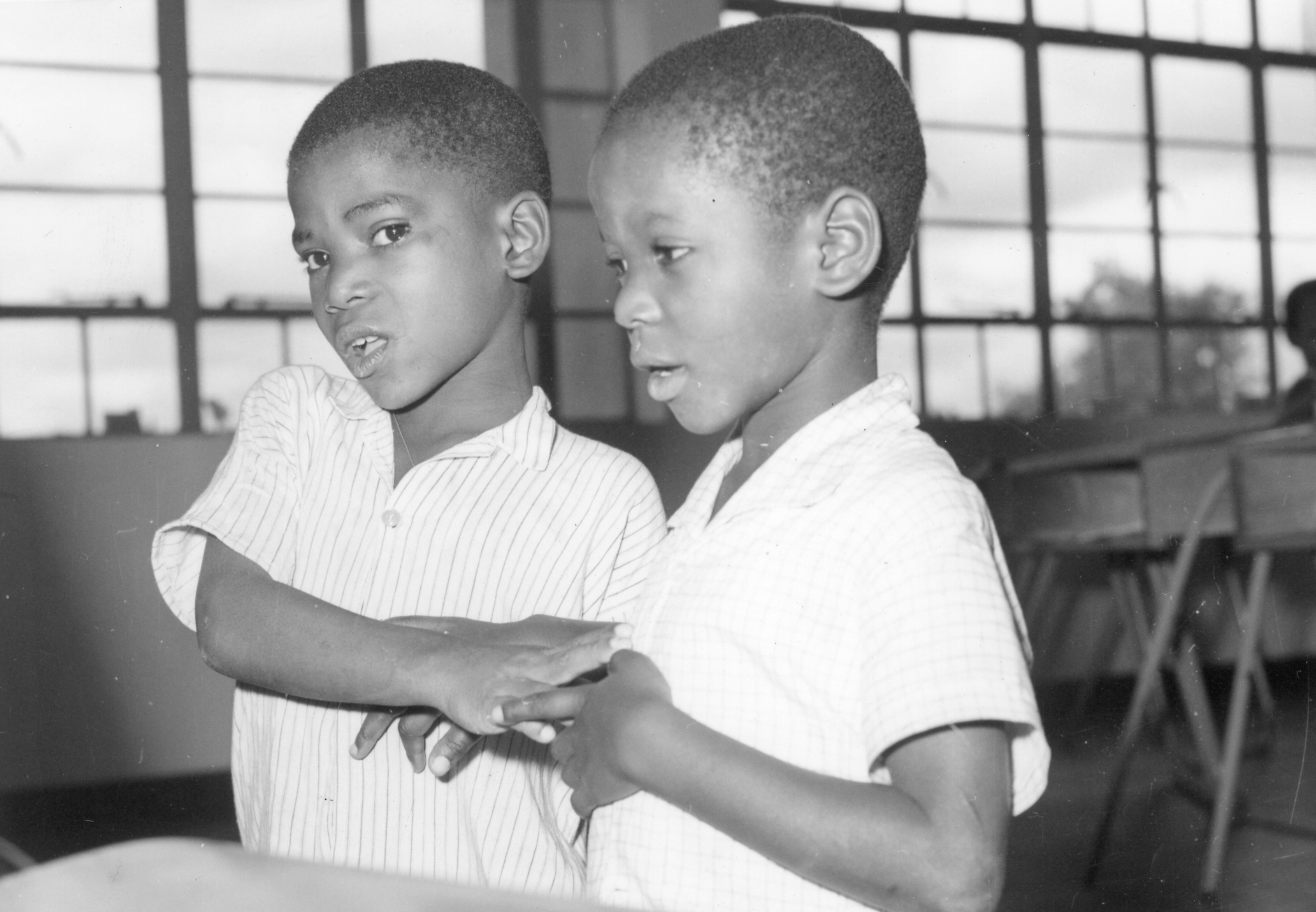
2. Two young boys sitting next to each other in class (Tabora, Tanzania, 1965) -
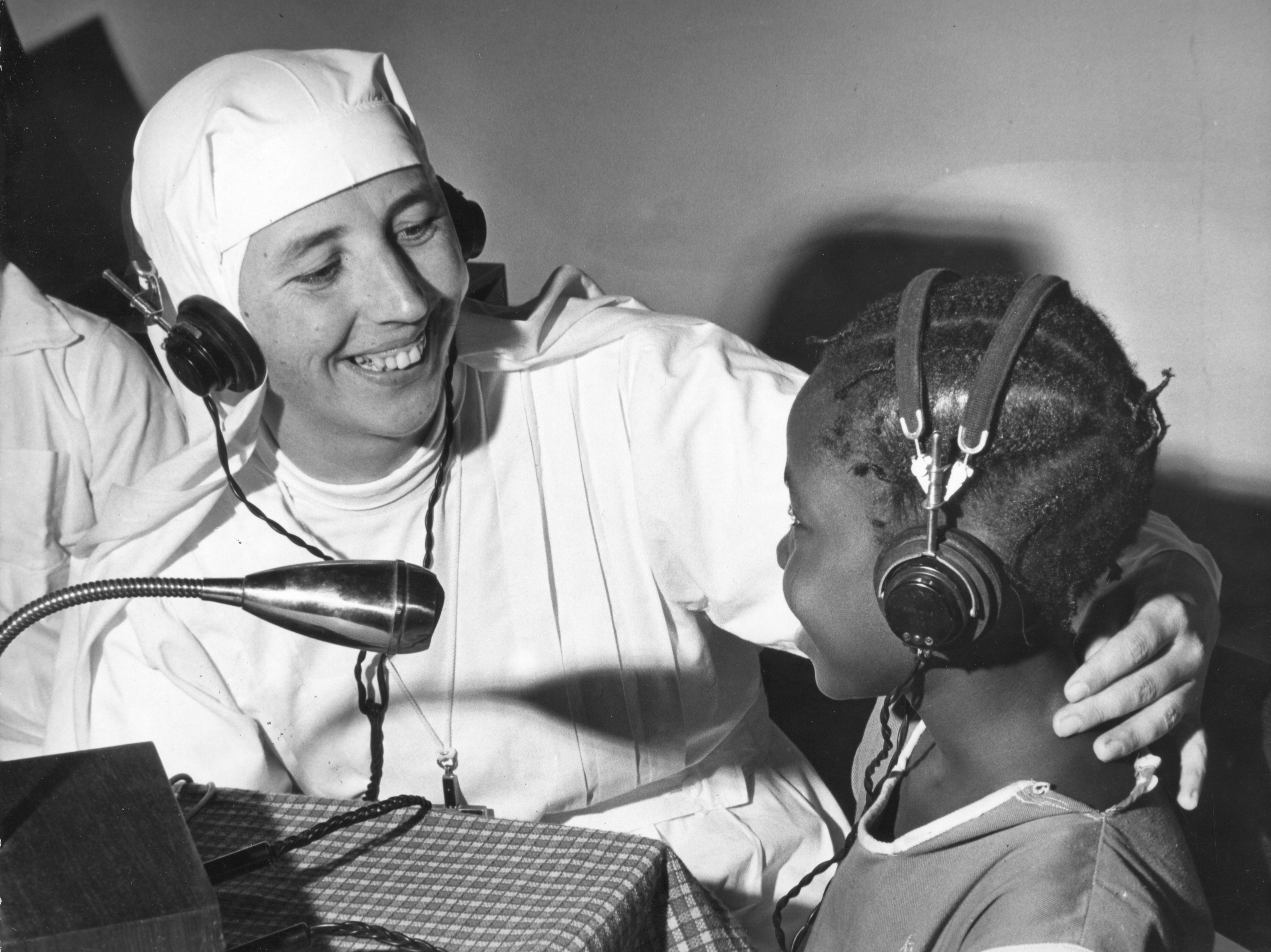
3. Deaf student with headphone and a missionary sister (Beno, DR Congo, n.d.) -

4. Deaf student prepares food (DR Congo, n.d.) -
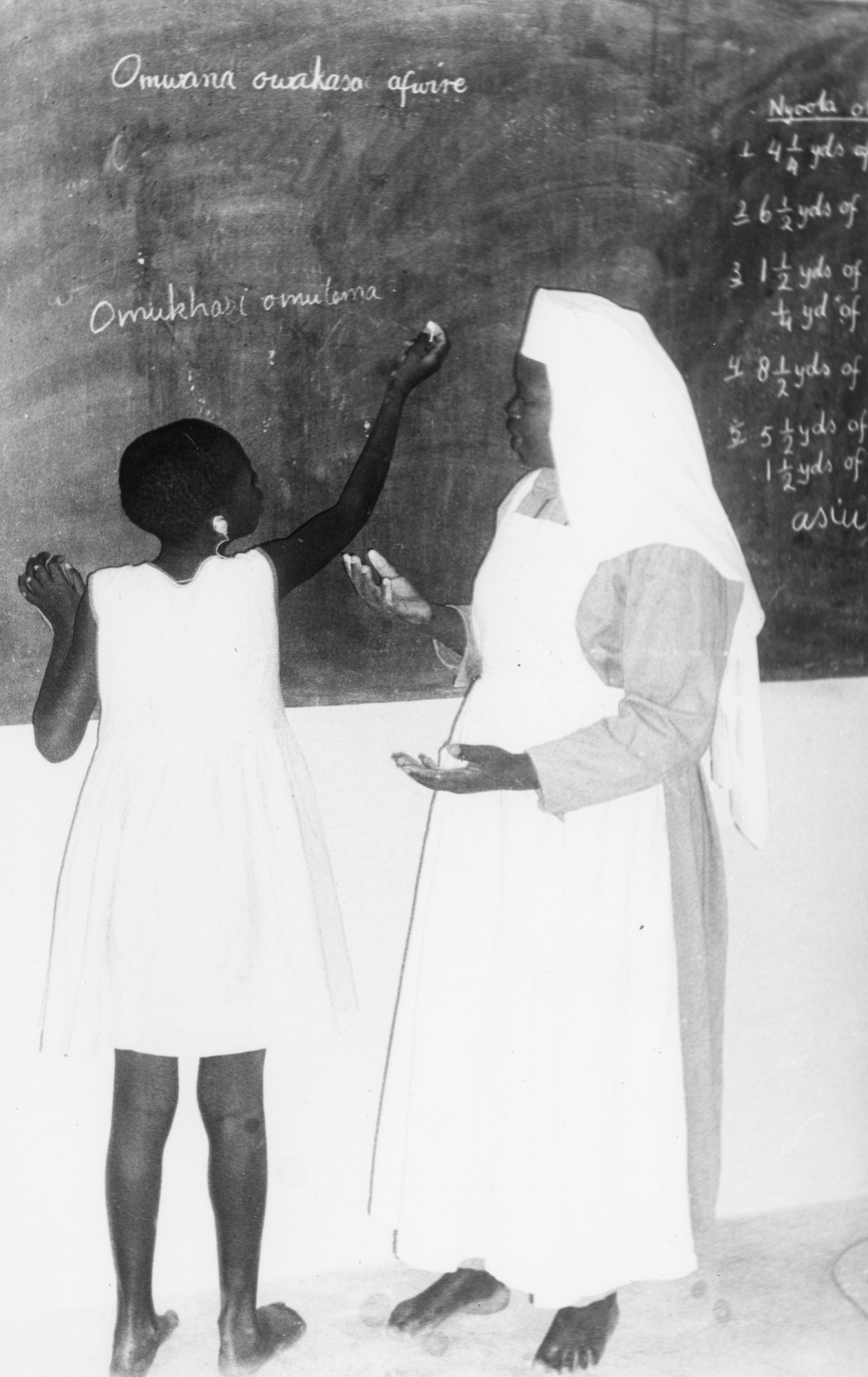
5. Deaf girl writing on a school board under supervision of a sister (Kenya, 1967) -
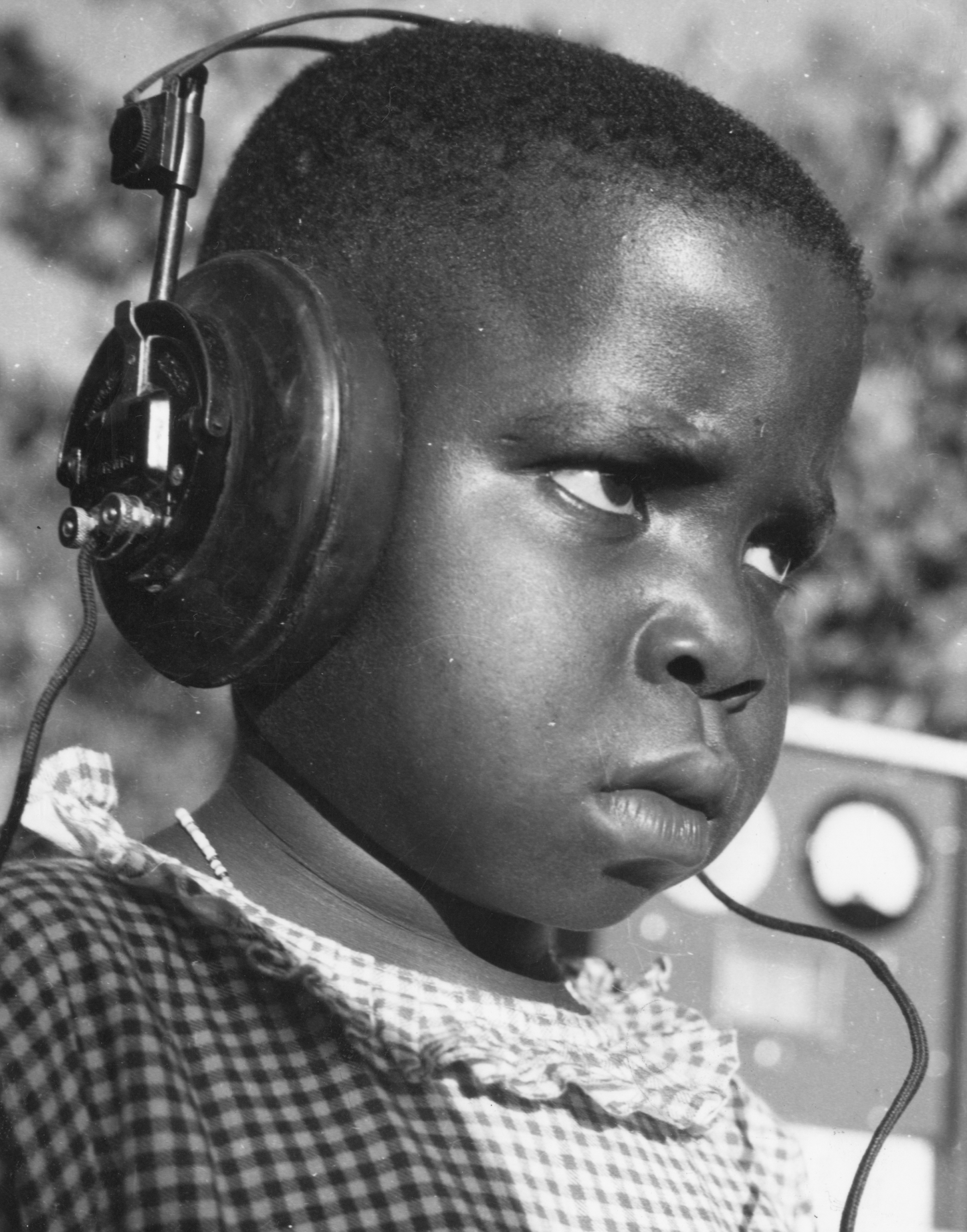
6. Deaf girl with a headphone looking at something outside the photo (DR Congo, 1958) -

7. Outside speech therapy class (South Africa, 1965) -
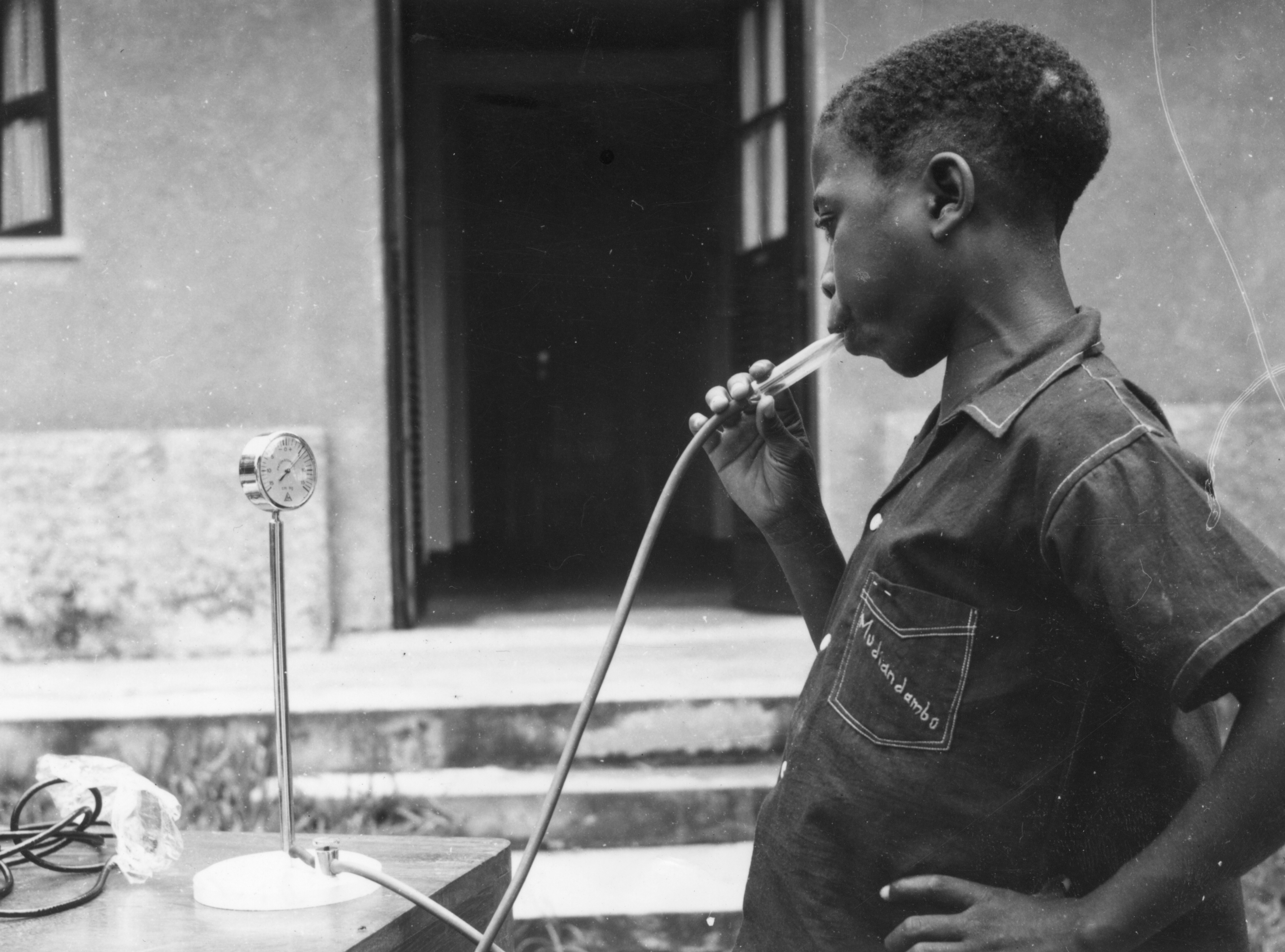
8. Demonstration of the machine training for air flow (Beno, DR Congo, 1957) -
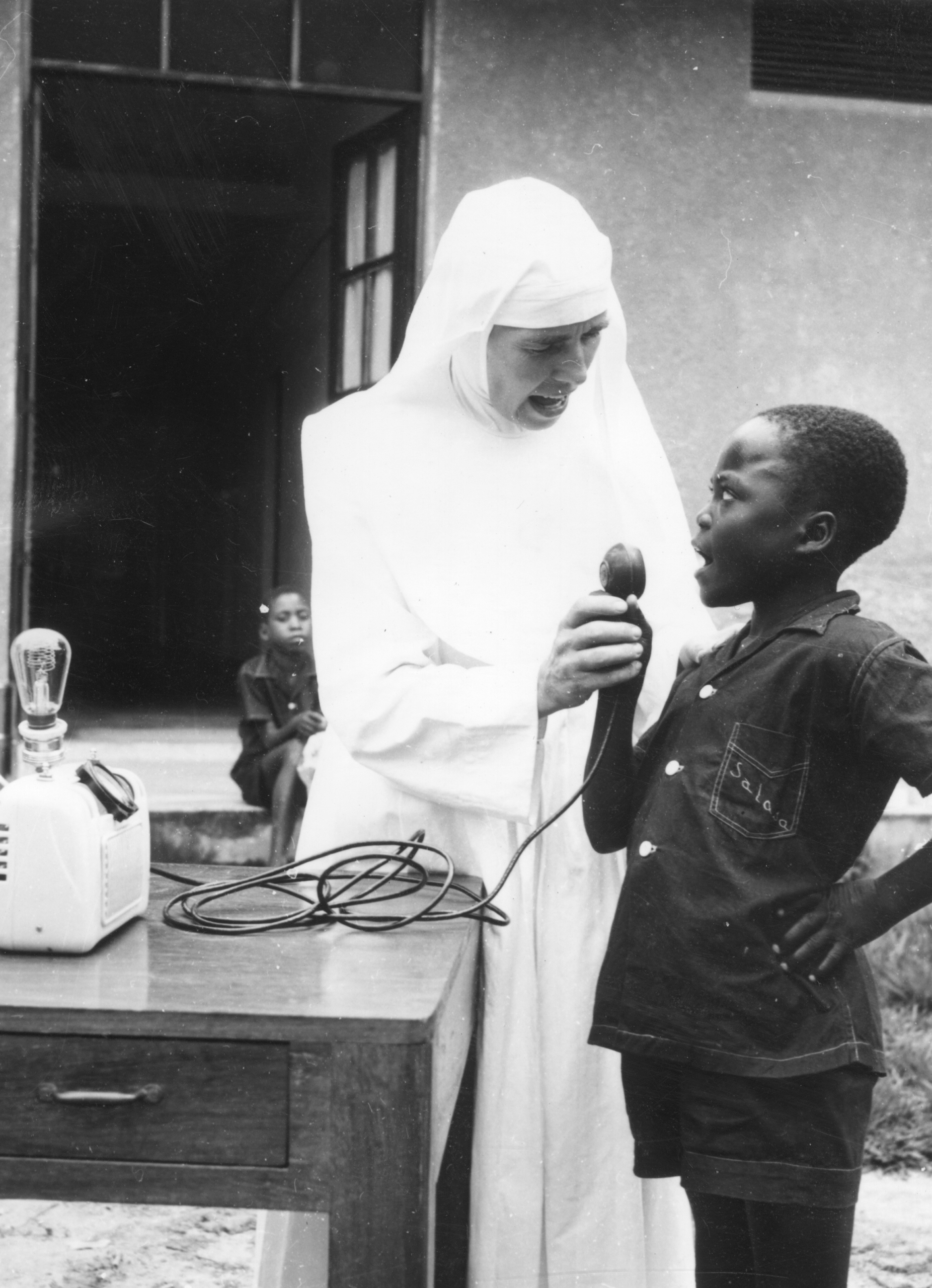
9. Demonstration of a speech therapy device with a lamp (Beno, DR Congo, 1957) -
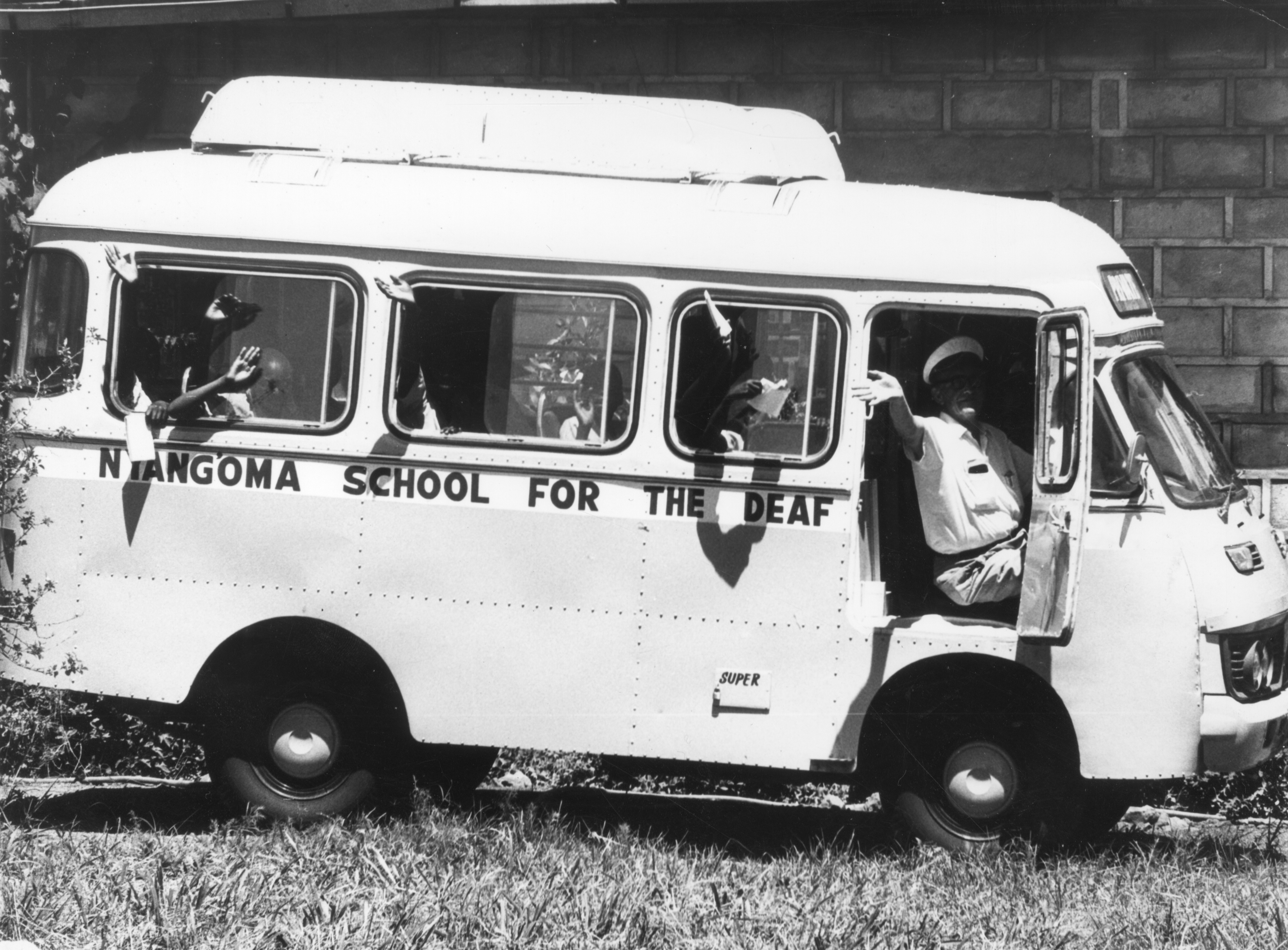
10. Nyang'oma schoolbus (Nyang'oma, Kenya, n.d.) -
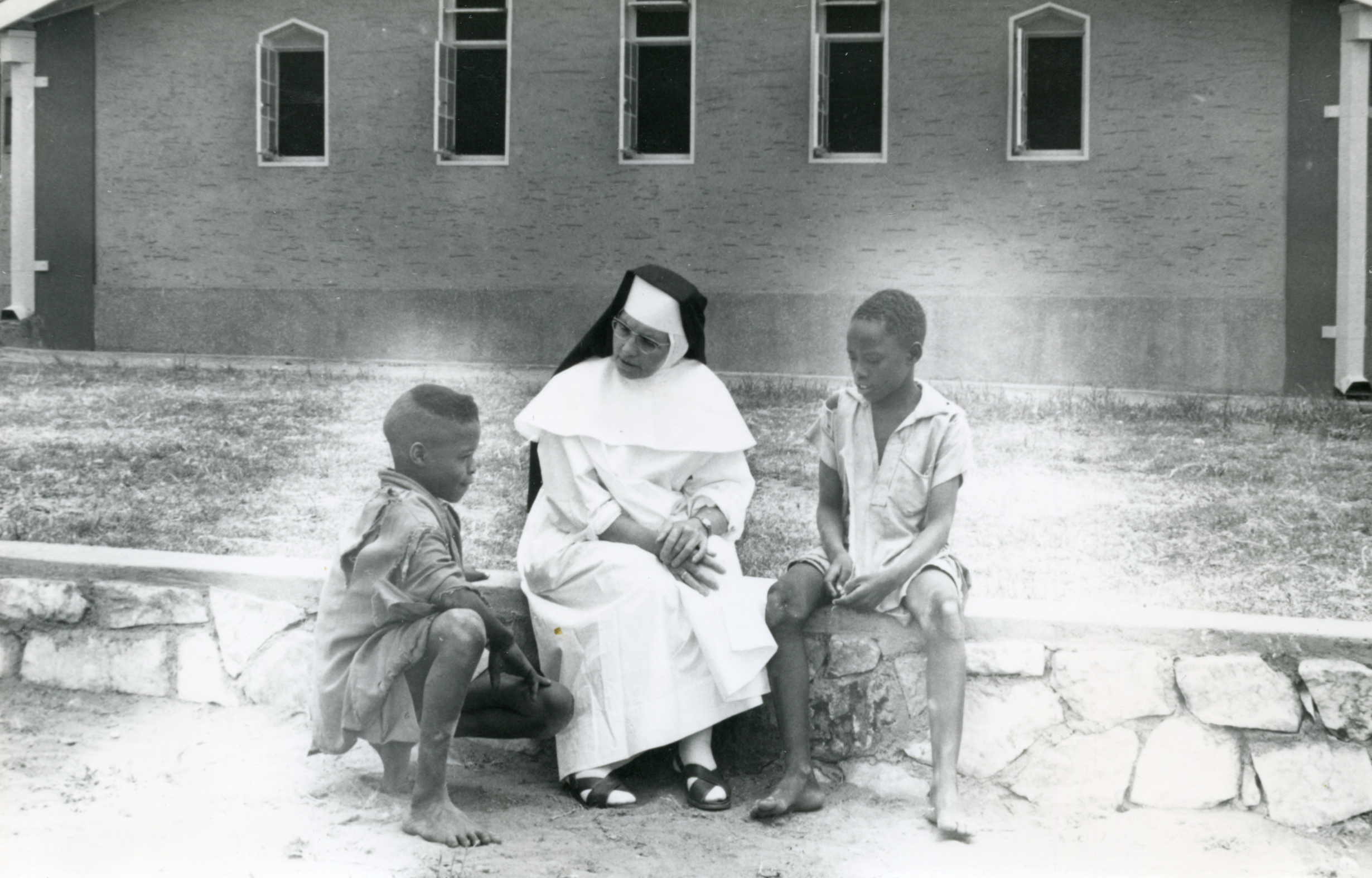
11. Sister sitting outside with two students (South Africa, 1965)
Image Descriptions
The number of the image description correspondences with the number of the photo in the gallery. All pictures are black and white.
- Deaf girl with a white dress and wearing a white headphone on her head sits in front of a device with a microphone. She looks into the camera. Father Piet Bergman and other adults surround her.
- Two black boys (6 and 7 years old, white shirts with short sleaves) sitting side by side, sharing the same desk in a classroom with large windows.
- White sister with headphones on and a broad smile on her face, with her hand around the shoulder of a student, also with headphones on. They sit at a table with a microphone and a device on it.
- Black girl (about ten years old, short hair, sleeveless dress) winnowing rice or something similar. Two toddlers stand by. In the background the houses of a village are visible, some round with straw roofing, others square with what seems to be iron roofing.
- A black student of about 12 years is writing with a piece of chalk on a blackboard. She has short hair and has a white, electronic hearing aid in her ear. She wears a white dress and is bare foot. Next to her stands a black sister (light (grey?) tunic, white scapular and veil, no shoes), holding her hands slightly raised, palms up.
- A young, black girl with a stern look on her face wearing big headphones, in front of what seems to be an instrument of measurement (out of focus).
- A white sister (white habit, with black dotted lines on the side and black, black veil) sitting outside on a chair, surrounded by five black children sitting in the grass. One black boy is standing in front of the sister, with his mouth wide open. He’s holding his jaw with one hand, with the other he holds the back of his head. The sister is holding his hands.
- A black boy, about 8 years old, blows into the tube of a what seems to be an instrument for measuring air pressure. His name on his school uniform shirt says Mundiandambo.
- A white sister (white habit, white veil) holds the hand of a black boy (shorts and a school uniform shirt with his name Salasa). The boy holds a microphone, connected to a machine with a lamp on the table in front of both. Both the sister and the boy have their mouths open as if saying [a].
- A white bus with the text NYANGOMA SCHOOL FOR THE DEAF written on its side. Black children are waving from inside the bus. The white driver (white shirt, black glasses, white captain’s hat) is waving from his open door.
- Two black boys (torn clothes, bare feet) and a white sister (white habit, black veil, white socks in sandals, wearing a watch and glasses) sit outside in front of a building, probably a deaf school. They seem to be having a conversation, hands in their laps.
Gallery sources
In order of appearance of the photos in this gallery, their sources are listed
- Deaf girl with headphone looking in the camera. Father Piet Bergman and other adults surround her
Pauselijke Missiewerken (Missio). (n.d.). De Witte Pater P. Bergmans is directeur van het doofstommeninstituut van Tabora [photograph]. Collectie Afbeeldingen klein formaat (1b15947). Katholiek Documentatie Centrum, Radboud University Library, Nijmegen, the Netherlands.
- Two young boys sitting next to each other in class
Landelijk centrum van de Katholieke Actie. (1965). De jongste kinderen, Moslim en Katholiek, 6 en 7 jaar oud, in de school voor doven in Tabora, gebouwd met geld van de vastenactie [photograph]. Collectie Afbeeldingen klein formaat (1a33599). Katholiek Documentatie Centrum, Radboud University Library, Nijmegen, the Netherlands.
- Deaf student with headphone with a missionary sister
Bijeen. (n.d.). In de missieschool van Béno hebben missiezusters een school geopend voor doofstomme kinderen [photograph]. Collectie Afbeeldingen klein formaat (1b16061). Katholiek Documentatie Centrum, Radboud University Library, Nijmegen, the Netherlands.
- Deaf student tosses food. Two little children in the background
Vivante Afrique. (n.d.). Doofstom meisje helpt bij het bereiden van het dagelijks voedsel [photograph]. Collectie Afbeeldingen klein formaat (1b15277). Katholiek Documentatie Centrum, Radboud University Library, Nijmegen, the Netherlands.
- Deaf student writing on a school board under supervision of a sister
Rome Agenzia Fides. (1967). Doofstomenschool [photograph]. Collectie Afbeeldingen klein formaat (1a13844). Katholiek Documentatie Centrum, Radboud University Library, Nijmegen, the Netherlands.
- Deaf girl with headphone looking at something outside the photo
Pauselijke Missiewerken. (1958). [photograph]. Collectie Afbeeldingen klein formaat (1a35885). Katholiek Documentatie Centrum, Radboud University Library, Nijmegen, the Netherlands.
- Outside speech therapy class (with tactile feedback)
Oriëntatiecentrum voor Kerkelijke Roeping. (1965). [photograph]. Collectie Afbeeldingen klein formaat (2b2372). Katholiek Documentatie Centrum, Radboud University Library, Nijmegen, the Netherlands.
- Demonstration of the machine for training of air flow
Pauselijke Missiewerken. (1957). [photograph]. Collectie Afbeeldingen klein formaat (1a35886). Katholiek Documentatie Centrum, Radboud University Library, Nijmegen, the Netherlands.
- Demonstration of speech therapy device with a lamp
Pauselijke Missiewerken. (1957). [photograph]. Collectie Afbeeldingen klein formaat (1a35886). Katholiek Documentatie Centrum, Radboud University Library, Nijmegen, the Netherlands.
- Nyang'oma schoolbus
Missie Verkeersmiddelenactie (n.d.). [photograph]. Collectie Afbeeldingen klein formaat (1a25524). Katholiek Documentatie Centrum, Radboud University Library, Nijmegen, the Netherlands.
- Sister sitting outside with two students
Oriëntatiecentrum voor Kerkelijke Roeping. (1965). [photograph]. Collectie Afbeeldingen klein formaat (2b2378). Katholiek Documentatie Centrum, Radboud University Library, Nijmegen, the Netherlands.
Background stories
Besides listing sources and materials of archives, we try to unveil the stories behind the gallery photos that seems to be taken randomly at first sight.
These background stories will appear in this section.
If it happens that you recognize a photo, have a contribution and/or know a story or an anecdote that you want to share, please let us know by sending an email to v.a.s.nyst@hum.leidenuniv.nl

Solving a missionary picture puzzle - By Victoria Nyst
This picture was found in the archives of the Catholic Documentation Center. According to the information given, it was taken in 1967 by Agenzia Fides, the “Information service of the Pontifical Mission Societies” since 1927. The picture is entitled Doofstommenschool MAPMIS 92 and carries the keywords ‘Afrika’ and ‘Missie’ (i.e., Africa and Mission). The picture is interesting for several reasons. One of them is that the picture is probably carefully staged, in a time where a picture was a valuable item.
Curious to see if we could find out more about where this picture was taken, we tried to identify the writing on the board. It says: Omwana owakasa afwire and Omukhasi omulema. The structure of the sentences pointed us in the direction of a Bantu language, but that still left us with several hundreds of candidates. Next to the sentences, there is a list of calculations, using the abbreviation ‘yds’ for yards. This narrowed down our search to English-speaking countries. With the help of several colleagues, the written phrases turned out to be Luhya, spoken in Western Kenya. The sentences on the board mean ‘The good/beautiful child died’ and ‘The disabled woman’. There are not many deaf schools in the Luhya speaking area that are also Catholic. In 1967 only one of them had already been opened; the deaf school in Mumias.
The picture is also interesting because it suggests that Luhya was used in deaf education at the time. Nowadays, the main languages used in deaf education are Kenyan Sign Language and English.
Thanks to Evans Namasaka Burichani, Jenneke van der Wal, and Hope Morgan!

